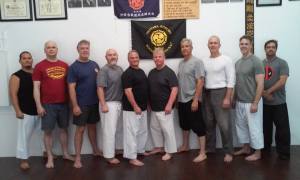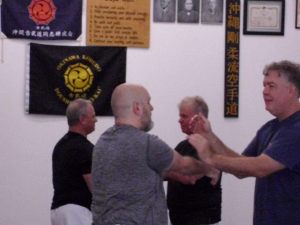I recently had the chance to spend another weekend training with my friend Sensei Russ Smith. He ran a small weekend training at his dojo in Florida. Once again his focus was on the whys of application in Goju and how they relate to some of the southern Chinese systems. Whys are difficult to frame sometimes. The word “principles” has become common lately. People keep using it but I do not think it means what they seem to think it means. To me principles bind a practice. They are limiters more than anything else, taking away options that do not conform with the ideas they represent. More often I seem to see vague “principles” that instead of limiting allow the teacher to fit just about any technique that occurs to him or her into their rubric. Not really helpful, at least to me.
Russ sensei has put together an approach to training that is principle centered in what seems like a very functional way. Instead of vague ideas that sound like a translation of the Book of 5 Rings the principles he is talking about are directly linked to physical action. One example might be Strong on Weak. That can sound esoteric but in practice it simply means not using the weaker parts of your body against stronger parts of the opponent- not trying to lever the elbow out of the way with the wrist for example. Attached to the principles are simple drills that demonstrate them, so the ideas are not just hanging out there but are immediately accessible.
This last one is really important. Ideas and principles are great, but if you cannot put them into action they are pretty much useless. One nice measure of that action is if they enable self-correction. Can a student, or anyone new to the principle, use it once it has been explained and they have done some time with an appropriate drill to feel it in action? I watched people over the weekend take an approach they were using and, when it didn’t work, go back to the ideas we were talking about and try to figure out why. What principles did it violate and how did that make it fail? This is was in unscripted practice, not set drills. In this environment people new to the material were able to use it, to break down their movement and application and use the ideas that bind the art to adjust it.
That seems like a good approach to the whys of practice to me. Why do something? Because it works. Because it fits the moment. And the same goes, really, for spending the weekend training with friends. Why do it? Because it works. Russ sensei runs a good training weekend. He has a lot to share and a good platform developed to do it with. And that format is important, because instead of a lecture or repetition of forms or basics (all necessary but able to be done mostly alone, IMO) I believe we learn better by interacting, testing each other and the ideas. That is a better way to spend time than memorizing yet another drill or form or technique, doing hundreds of reps you could have just done at home, or going to “get instruction” from someone who is just going to tell you to do it their way. Instead share, grow, and have fun doing it. Taking some time with the whys can enable you to better direct your own practice. That and a glass of usquebaugh and good conversation at the end of a fun day seems like good whys to me indeed!



Great interpretation on this gathering. And an awesome experience I look forward to doing again.
LikeLike
Thanks Gregory. I had a great time, and it was a blast to meet and train with you.
LikeLike